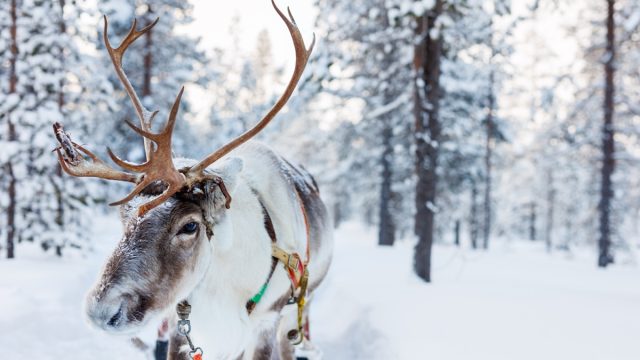This Is Why Santa Has Reindeer

By now, Santa’s reindeer are practically synonymous with old St. Nick himself. After all, without these magical flying beasts, how would the king of Christmas deliver all of his gifts on time? Still, the idea of airborne caribous that allegedly land on roofs without a sound is kind of strange, which is why we decided to dig a bit deeper into the subject. And it turns out, this Christmas “tradition” isn’t all that traditional at all.
The first time Santa’s preferred mode of transportation was mentioned in popular culture was in Clement Clarke Moore’s poem “The Night Before Christmas,” written in New York in 1822. But long before Moore wrote his poem, these animals were heralded as icons in Northern Europe. There, the Sami people, the oldest still-surviving indigenous people, spanning parts of Norway, Finland, Sweden, and the Kola Peninsula of Russia, herded the deer and used them for transport, milk, and meat production, according to CNN.
Reindeer first made their way to America in the mid-1800s with the help of entrepreneur Sheldon Jackson, who was looking to help the native Alaskan Inuit people survive starvation. At the time, the group’s main food source, whales, was quickly disappearing due to commercial fishing. When reindeer proved beneficial to the people of Alaska, Carl Lomen, an enterprising businessman from Minnesota, saw a bigger market for the animal on the mainland—as an alternative to beef and a novelty fur.
In a clever marketing scheme in 1926, Lomen convinced the Macy’s department store to develop a promotional Christmas parade led by Santa and his reindeer, along with several Sami herders in vibrant traditional dress. Similar parades began popping up across the U.S., and eventually, Santa and his reindeer became the centerpiece of every town’s celebration of the holiday season. Lomen is even thought to have planted fake letters from children in local newspapers, asking Santa to bring his reindeer to come to visit their town.
In some ways, Lomen’s tenacity—however questionable—paid off. In the 1920s, Lomen Reindeer Co. owned more than a quarter-million reindeer. Lomen himself even became known as “the reindeer king”—a title that could make even the highest-ranking royal jealous. Unfortunately, progress soon came to a halt. Reindeer meat never caught on in America, and in 1937, after pressure from the cattle lobby, Congress decided that only indigenous American cultures could own reindeer in the U.S. The act put the final nail in the coffin on Lomen Reindeer Co.
Though Lomen’s business failed, the holiday tradition he conceived of prevailed. Worldwide, Santa enjoyed a surge in popularity, and in most depictions, his reindeer were right there by his side. Still, as any fan of “The Night Before Christmas Knows,” there was one reindeer—perhaps the most famous one of all—that still hadn’t made his debut. That’s right, Rudolph, with his glowing red nose, was not one of the eight original reindeer (“Now, Dasher! now, Dancer! now, Prancer and Vixen! / On, Comet! on Cupid! on, Donner and Blitzen!”)
Instead, his tale was told through a coloring book created by the now-defunct Montgomery Ward Department Stores. Since this illustration of Rudolph and his friends in 1939, the world has not witnessed a Christmas without the presence of these wise and helpful animals, guiding Santa Claus on his mission to bring toys to boys and girls on the most magical night of the year. It’s a history that combines both commercial interests with holiday cheer, a union that would make any Hallmark executive proud. For more fun facts about the holiday season, learn the Secret History Behind 20 Christmas Traditions.
To discover more amazing secrets about living your best life, click here to follow us on Instagram!